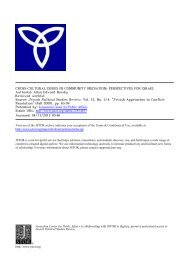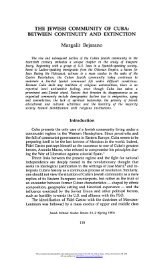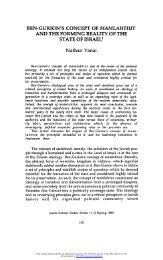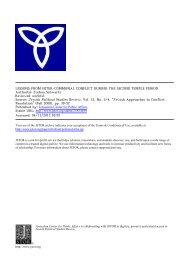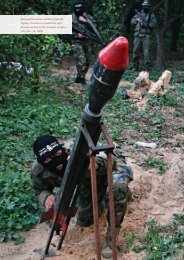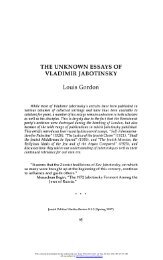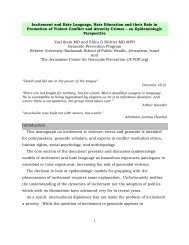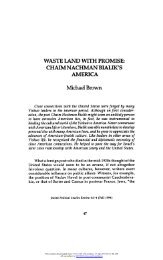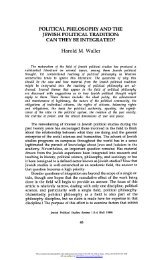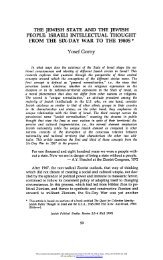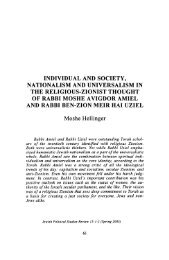Linking the Gaza Strip with the West Bank: - Jerusalem Center For ...
Linking the Gaza Strip with the West Bank: - Jerusalem Center For ...
Linking the Gaza Strip with the West Bank: - Jerusalem Center For ...
Create successful ePaper yourself
Turn your PDF publications into a flip-book with our unique Google optimized e-Paper software.
ֿpage 50The fifth and final cause of<strong>the</strong> war was <strong>the</strong> impact of amajor hurricane that affectedEast Pakistan. The apathy of<strong>the</strong> <strong>West</strong> Pakistani leadershipand <strong>the</strong>ir failure to aid EastPakistan only aggravated analready tense situation. 284Clearly, while Pakistan had been non-contiguous, itsnon-contiguity had not caused its dissolution. In fact, itplayed no role in its dissolution. Calls for a sovereignterritorial link between <strong>the</strong> <strong>West</strong> <strong>Bank</strong> and <strong>Gaza</strong> <strong>Strip</strong>and <strong>the</strong>refore, contiguity cannot point to <strong>the</strong> Pakistaniexperience.A fur<strong>the</strong>r example that could perhaps be cited by thosein favor of <strong>the</strong> creation of a safe passage is that of <strong>the</strong>Danzig Corridor.However, when examined carefullythis example also fails to support <strong>the</strong> creation of safepassage. Indeed, it demonstrates <strong>the</strong> threat that suchpassage could pose.The Polish Corridor was a strip of territory transferredfrom Germany to Poland by <strong>the</strong> Treaty of Versaillesin 1919. The transfer of <strong>the</strong> territory was said to bejustified on historical, ethnographic, economic, andpolitical grounds. Historically, <strong>the</strong> territory had beenPolish from <strong>the</strong> tenth century till <strong>the</strong> fourteenth century,and from approximately 1453/66 till 1772, when it wastransferred to Prussia. Ethnographically <strong>the</strong> majorityof <strong>the</strong> population was Polish, or Kashubian (a peoplewho consider <strong>the</strong>mselves Polish). Only a minority of <strong>the</strong>population was German. Economically and politically<strong>the</strong> Poles were able to convince Britain and France thatif <strong>the</strong> new Polish state did not have an outlet to <strong>the</strong> BalticSea, it would be economically and politically dependenton Germany. Wanting a strong Polish state, Britain andFrance accepted this argument. 285The corridor ranged from 20-70 miles wide. It separatedEast Prussia from <strong>the</strong> rest of Germany. Although freeGerman transit was permitted across <strong>the</strong> corridor, <strong>the</strong>rewas great resentment in Germany, <strong>with</strong> all post-WorldWar I German governments refusing to recognize <strong>the</strong>borders agreed to at Versailles. 286 The important seaportof Danzig was made <strong>the</strong> ‘Free City of Danzig’ and placedunder <strong>the</strong> control of <strong>the</strong> League of Nations. 287In 1933, <strong>the</strong> Nazi Party, led by Adolf Hitler, came topower in Germany. Initially, Hitler adopted a policy ofrapprochement <strong>with</strong> Poland, even concluding <strong>the</strong> Polish-German Non-Aggression Pact of 1934. Following <strong>the</strong>annexations of Austria and Czechoslovakia, Hitler turnedhis attention to Poland. In early 1939, <strong>the</strong> Germangovernment intensified demands for <strong>the</strong> annexation ofDanzig, as well as for construction of an extra-territorialroad (under German sovereignty) through <strong>the</strong> Corridor,connecting East Prussia <strong>with</strong> <strong>the</strong> rest of Germany.Poland, <strong>with</strong> <strong>the</strong> support of Britain and France, rejected<strong>the</strong>se demands. This was to no avail, as in September,1939, Germany invaded Poland, and after Poland wasunder German control, Danzig and <strong>the</strong> Polish Corridorwere re-annexed to Germany. 288Although some might see <strong>the</strong> case of <strong>the</strong> DanzigCorridor as a justification for safe passage, and arguethat had <strong>the</strong>re been safe passage Germany would nothave invaded Poland or re-annexed <strong>the</strong> Corridor, in <strong>the</strong>authors’ opinion this is clearly not <strong>the</strong> case. Germany hadin fact enjoyed free transit across <strong>the</strong> corridor. The statewas <strong>the</strong>refore contiguous, even though <strong>the</strong> territory usedfor transit was not sovereign German territory. Therewas no need for <strong>the</strong> German invasion based on calls forcontiguity. Germany attacked not because she was noncontiguousbut because Hitler’s government had adoptedan aggressive expansionist policy.Therefore, this example does not support <strong>the</strong> call forsafe passage between <strong>Gaza</strong> and <strong>the</strong> <strong>West</strong> <strong>Bank</strong>. In fact,it militates against such passage. The Palestinians,like <strong>the</strong> Germans, have adopted an expansionist policy,in <strong>the</strong> form of <strong>the</strong>ir ‘phased approach.’ This calls for



